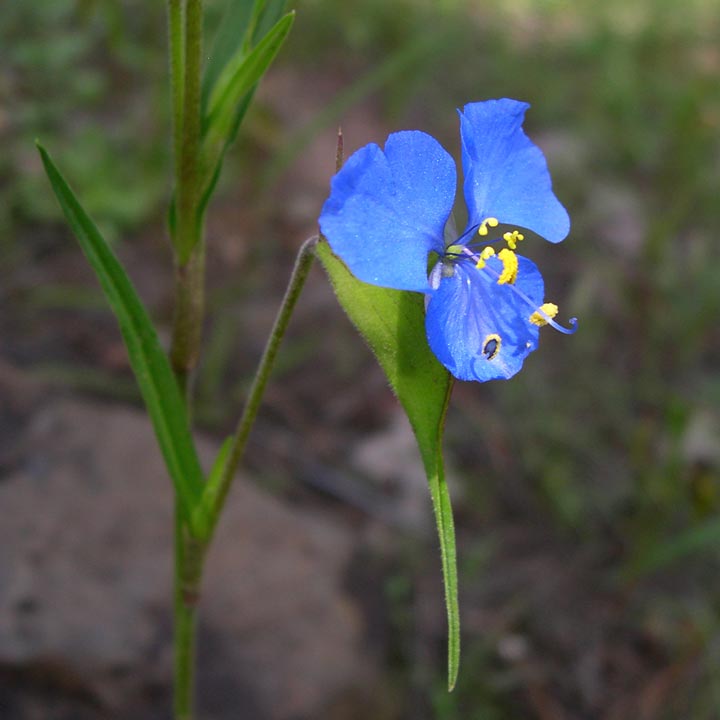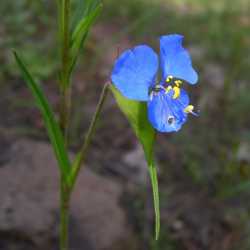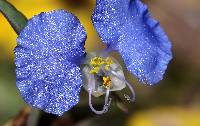Herbs, perennial or annual. Roots thin or tuberous. Leaves 2-ranked or spirally arranged, not glaucous; blade sessile or petiolate. Inflorescences terminal, leaf-opposed; cymes 1--2, enclosed in spathes, proximal cyme several-flowered, distal cyme vestigial or with 1--several staminate flowers; spathes often filled with mucilaginous liquid, margins distinct or basally connate; bracteoles usually absent. Flowers bisexual and staminate, bilaterally symmetric; pedicels well developed; sepals distinct or proximal 2 connate, unequal; petals distinct, proximal petal often different color than distal 2, smaller or subequal, distal 2 blue (occasionally lilac, lavender, yellow, peach, apricot, or white), clawed; stamens (5--)6, proximal 3 fertile, medial different in form, size from others, distal (2--)3 staminodial; filaments glabrous; antherodes commonly 4--6-lobed; ovary 2--3-locular, ovules 1--2 per locule, 1-seriate. Capsules 2--3-valved, 2--3-locular. Seeds 1--2 per locule; hilum linear; embryotega lateral. x = 11--15.
PLANT: Annual or perennial herbs, the roots thin or tuberous. STEMS prostrate to erect. LEAVES lanceolate to linear lanceolate.
STEMS: prostrate to erect.
LEAVES: lanceolate to linear lanceolate.
INFLORESCENCE: terminal and leaf-opposed, composed of 1-2 cymes enclosed in spathes, the upper cyme lacking or producing 1 staminate flower, the lower cyme several flowered; spathes with margins free or fused basally, often filled with mucilaginous liquid.
FLOWERS: perfect or staminate, zygomorphic; sepals free or lower 2 connate; petals free, the upper 2 usually blue (occasionally lilac or lavender), clawed, the lower petal often smaller and different in color from the upper 2; stamens 6, the upper 3 staminodial, the sterile anthers commonly 4-6 lobed, the lower 3 stamens fertile, the medial different in form and size from the others; ovules 1-2 per locule.
FRUITS: 2-valved, 3-locular on ours.
SEEDS: 1-5, testa rugose or smooth, tan to brown, hilum linear.
NOTES: Ca. 170 species: almost cosmopolitan, mainly tropical (for Jan and Kaspar Commelijn).
REFERENCES: Puente, Raul, and Robert B. Faden. 2001. Commelinaceae. J. Ariz. - Nev. Acad. Sci. Volume 33(1).
Sep 3, herbaceous, somewhat unequal, 2 sometimes connate at base; pet 3, the upper 2 usually blue, ovate to reniform, clawed at base, the lower one smaller, in most spp. white; fertile stamens 3, 2 with oblong anthers, one incurved with a longer anther; sterile stamens (2)3, smaller, with imperfect, cruciform anthers; filaments not hairy; ovary sessile, 3-locular, the lower 2 locules fertile, with 1 or 2 ovules, the upper median locule smaller, 1-ovuled or empty, or abortive; fr a loculicidal, 2-3-valved capsule; herbs with succulent stem and linear to lance-ovate lvs; infl of small cymes, each closely subtended by a folded cordate spathe from which the pedicels protrude (or sometimes 2 cymes to a spathe); usually self-pollinated. 200+, cosmop., mostly warm reg.
Gleason, Henry A. & Cronquist, Arthur J. 1991. Manual of vascular plants of northeastern United States and adjacent Canada. lxxv + 910 pp.
©The New York Botanical Garden. All rights reserved. Used by permission.









